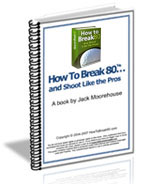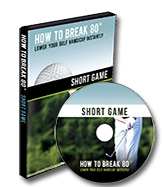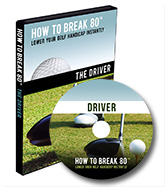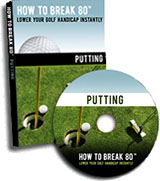|
===================================================
How To Break 80 Newsletter
March 21, 2007
"The Web's Most Popular Golf Improvement Newsletter"
===================================================
In this issue we'll discuss...
1) Harnessing Your Hook
2) Stopping Front Foot Spin
3) Question of the Week- Achieving Consistency in Greenside Bunkers
4) Article- Curing Your Slice
5) Article- What Your Finish Position Can Reveal About Your Swing Flaws (Part II)
===================================================
1) Harnessing Your Hook
===================================================
Some people say that fixing a hook is easier than correcting a slice. Perhaps it is, but personally, I think they are equally hard to fix. To me it seems that the person with the hook struggles just as much to correct it as the person with a slice works to fix the slice. To correct a hook, you need to make some adjustments to your swing and you need to practice those adjustments until they're ingrained.
Let's take a look at the various ways to fix a hook:
Use a slicer's grip
If you hook the ball, it may be due to excessive hand and wrist rotation through the downswing. So instead of hitting the ball with a squared clubface, you hit it with a closed one. If that's why you hook curing the problem is to adopt a slicer's grip. At address, instead of having the two folds in your hands between both thumbs and index fingers pointing to the right shoulder (right-handers), point both folds more toward your sternum. The change not only prevents a closed clubface at impact, but also encourages you to get more of your body into your swing.
Turn and burn
Another reason why you may hook is that your body fails to turn during your swing. When the body fails to turn, the clubface closes too fast, causing the ball to hook. If that's the case, the way to cure the problem is simply to speed up your turn to the target. Increasing your body's rate of rotation delays the closing of the clubface, eliminating the hook.
Equipment changes
A third way to fix a hook is to make some equipment changes. For one thing you could fatten your grips. That makes it more difficult for you to over-rotate and hook the ball. Another thing you might try is shortening the shafts on your club. The shorter shafts make you stand a little more upright. You may lose some distance doing this, but it's better being on the fairway short than out of bounds long.
Any of these three approaches will correct your hook. The trick is discovering which one works for you. That's the one you want to practice until it becomes second nature.
=================================================== 2)
Stopping Front Foot Spin
===================================================
Every so often you'll see a player who normally doesn't pull the ball suddenly hit a pull hook. Various swing flaws cause this problem, and one of the most common is front foot spin. You correct this swing flaw by working on your footwork and your body rotation.
In a solid finish, the left foot remains planted. In a less-than-solid finish, the left foot sometimes spins out—indicating that you've rotated your body too quickly through the swing. Rotating too quickly leaves your weight stranded on your back leg, resulting in a dead pull hook that often leaves you in trouble.
Correcting this problem isn't hard. To ensure that your front foot remains planted, move your weight onto your left toe on the downswing, and then begin rotating your body. This move slows your body rotation, so you don't turn too quickly. Below is a drill that helps correct front foot spin.
Front Foot Spin Drill
To stop front foot spin, you must improve your body rotation and your footwork. First, stick a shaft in the ground just to the left of your forward hip. Now take the club back to the top of your swing, and then bump the shaft with your left hip at the start of the downswing. As you bump the shaft, you should feel your weight transfer to your front foot though the hitting area.
Focusing on your footwork also helps. When you swing, your weight moves from the toes at address, to the right heel at the top of the swing, into the left toe on the downswing, then finally to your left heel. Next time you're at the range or the club, take some practice swings focusing on your footwork. Soon, using the right footwork will become second nature and you won't have to focus on it any more.
If you've ever wondered why someone who normally doesn't pull the ball suddenly does, front foot spin could be the reason. By moving your weight onto your front toes, you'll eliminate this problem.
=================================================== 3)
Question of the Week- Achieving Consistency in Greenside Bunkers
===================================================
From Karunish Bal
From Troy D. Draughn
Q. Hi, Jack,
First of all, I want to thank you for providing tips on how to break 80. Your tips have improved my game immensely!
I have a problem getting out of greenside bunkers. I know part of the problem is not being able to practice the shot as much as I should. Could you give me some tips in that area?
A. Thanks for the question, Troy. You're not alone when it comes to greenside bunkers. Many weekend golfers have problems getting out of bunkers with consistency. The reason may be your approach. Most players use the traditional bunker shot approach, played with an open stance and the feet and shoulders aligned left of the target. This approach works well for some golfers, but not for others.
Since you play only a couple of shots from a bunker per round, it’s hard to feel comfortable and confident using this set up. Also, the severe outside-to-in swing path created by the open set-up makes it difficult for weekend golfers to hit the spot where they're aiming. Both of these things make it hard achieving consistency.
You might try a slightly different approach. Next time you're in a greenside bunker, instead of opening up, try either squaring your feet and shoulders to the target line, or opening them up ever so slightly. Open your clubface a bit, too. Then, take a normal swing, concentrating on maintaining a smooth tempo from start to finish.
Many golfers find it easier to start the ball on the correct line and judge the correct distance using this approach. It may be just what the doctor ordered to help you achieve more consistency punching out of greenside bunkers.
If you've got a golf question you'd like answered, send an email to us at
questions@howtobreak80.com and we'll review it. I can't guarantee that we'll use it but if we do, we'll make sure to include your name and where you're from.
===================================================
If you want to truly discover the secrets of shooting like the Pros and creating a more reliable and consistent swing, check out:
http://www.HowToBreak80.com
P.S. Feel free to share this newsletter with family and friends. If you
would like to subscribe to this newsletter, send a blank email to
break80ezine@aweber.com
===================================================
About the Author
===================================================
Jack Moorehouse is the author of the best-selling book
"How To Break 80 and Shoot Like the Pros!". He is NOT a golf pro, rather a working man that has helped thousands of golfers from all seven continents lower their handicaps quickly. His free weekly newsletter goes out to thousands of golfers worldwide and provides the latest golf tips, strategies, techniques and instruction on how to improve your golf game.
|
Tools To
Help Your Game!

eBook

Physical Book

Audio Program

Short Game DVD

Driver DVD

|